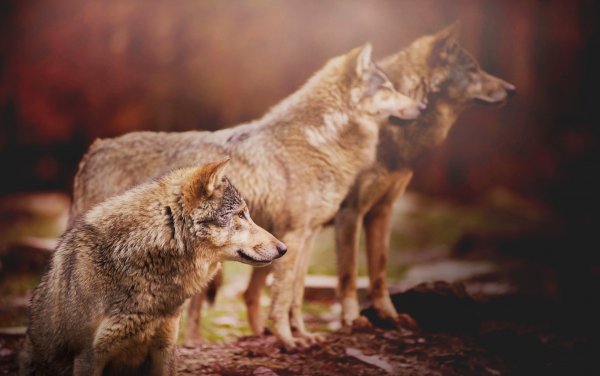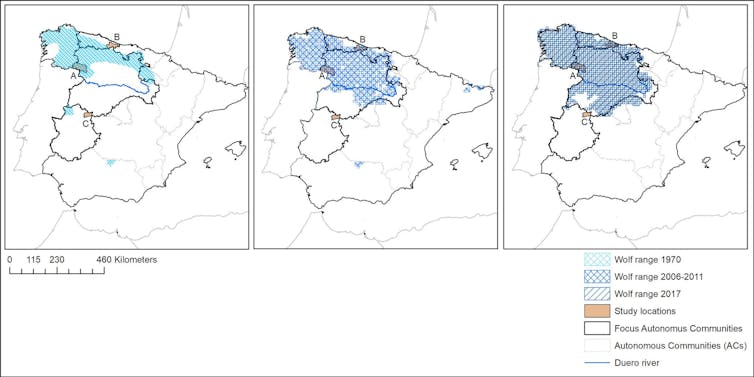How To Live With Large Predators – Lessons From Spanish Wolf Country
Tags: opinion

By Hanna Pettersson, University of Leeds
Elena and her husband are shepherds. Their herd of 400 free-roaming goats were bred over generations to make the most of the patchwork of woodlands and pastures that cover their local mountain range in central Spain.
This type of farming produces some of the most sustainable meat and dairy that money can buy. They use little feed and fertilisers and the goats maintain biodiversity-rich grasslands through grazing. Even so, eking out a livelihood here is becoming increasingly difficult. Across Spain, local butchers and cheesemakers have closed down, rigid food standards prevent farmers from selling directly to consumers and agricultural subsidies benefit those who produce a lot over those who produce a little.
Numbers of free-roaming sheep and goats have decreased drastically in areas like Elena’s, enabling shrub to reclaim old pastures and blur the boundaries between forests and villages. This has made wildfires more expansive, threatening homes. It has also enabled wild boar and deer to return in large numbers, raiding crops and causing outbreaks of bovine tuberculosis.
On top of all this, the wolf is at the door. Literally.
The wolf is a generalist that can hunt both wild and domestic prey. This flexibility, together with stricter conservation laws and better habitat conditions, has allowed their populations and those of other European carnivores (bears, lynx and wolverines) to rebound and reclaim old territories across the continent.
Many people, particularly city dwellers, welcome these changes. Attitudes towards predators have softened over the years as awareness of their important ecological role has grown. But in many rural areas, returning carnivores have come to symbolise the demise of traditional farming cultures. In some cases, their return has been met with suspected violence, as in the case of the first wolf in Belgium to bear cubs in over a century, who died in suspicious circumstances in 2019.
These are the cases we most often hear about. But there are also places in Europe where people are living relatively peacefully alongside carnivores. What’s behind these harmonious relationships, and how are people adapting to returning wolves elsewhere? This is what my research team and I set out to explore through case studies in Spain.

Hanna Pettersson, Author provided
Working with wolves
Elena (who lives at “C” on the map) had mixed feelings about wolves returning to her land. She hoped they might control the boar and deer, but she worried about how to prevent them from attacking her goats. She knew that protecting her flock would take a lot of time, money and expertise – none of which she has.
People in the region of Sanabria-La Carballeda in northwestern Spain (marked as “A” on the map), are accustomed to the challenges of coexisting with large predators. The area was one of the last bastions for wolves before hunting was regulated in the 1970s. Before then, wolves could be shot on sight. Today it has one of the densest wolf populations in western Europe, concentrated in the hunting reserve of Sierra de la Culebra.
To defend their livestock, shepherds here keep packs of up to 21 guard dogs with their flocks. They accompany their sheep as they graze during the day and then they lock them in at night. This reduces wolf attacks to a trickle.
While wolves are not universally liked, their permanent presence has allowed shepherds to refine these defence methods and transmit them from generation to generation, making them feel like a normal part of farming.
Wolves also generated income for local councils through trophy hunting. This was still legal when I was there, but was banned by the Spanish government in September 2021. A common local perception was that hunting helped control the expanding population.
Wolf tourism offers another income stream thanks to ideal conditions – a smooth topography with intermingled forests and open spaces. Companies offering wildlife enthusiasts a chance to spot wolves have sprouted in recent decades, making La Culebra peculiar as a place where wolf watching and hunting existed side by side.
However, this revenue doesn’t line the pockets of local livestock owners, and the meat they produce is not priced to reflect the benefits that this extra work generates for wolves and grasslands – unlike price premiums for sustainable fish, for example. Since farming among wolves entails additional work, many are struggling to make ends meet on the increasingly competitive global market.
One shepherd I spoke to concluded: “Those of us who live in wolf territory have significantly less quality of life than those who don’t.” The demise of the farming sector in La Culebra is a threat to coexistence with wildlife in Spain, since it represents one of the best examples of a functional relationship between wolves and traditional farming.
Coexistence and prosperity
So how can we ensure the future of both wolves and rural communities?
First of all, by funding successful coexistence. In Spain, funding for wolves, such as that provided by the EU, is predominantly dedicated to areas where there is conflict between the wolves and local populations. This means that the best chance for a Spanish shepherd to get financial aid, to keep guardian dogs or build a barn, is to live in a community where people are hostile towards wolves.
We need to ensure that places like La Culebra thrive, to illustrate to people like Elena, who warily anticipates the return of wolves, that living with them does not necessarily imply lower living standards. This could involve certification for sustainable meat, shepherd schools and networks that help shepherds share knowledge and collaborate, and paying them for environmental services, such as fire prevention through grazing.
By safeguarding rural livelihoods and sustainable farming, we can provide more space for Europe’s wild species to return.
Names were changed to protect the identities of the people in this article.![]()
Hanna Pettersson, PhD Candidate, Sustainability Research Institute, University of Leeds
This article is republished from The Conversation under a Creative Commons license. Read the original article.
Image Featured: 123RF
Leave Comment: